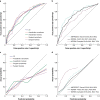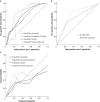Long-term risk prediction after major lower limb amputation: 1-year results of the PERCEIVE study
- PMID: 38266124
- PMCID: PMC10807997
- DOI: 10.1093/bjsopen/zrad135
Long-term risk prediction after major lower limb amputation: 1-year results of the PERCEIVE study
Abstract
Background: Decision-making when considering major lower limb amputation is complex and requires individualized outcome estimation. It is unknown how accurate healthcare professionals or relevant outcome prediction tools are at predicting outcomes at 1-year after major lower limb amputation.
Methods: An international, multicentre prospective observational study evaluating healthcare professional accuracy in predicting outcomes 1 year after major lower limb amputation and evaluation of relevant outcome prediction tools identified in a systematic search of the literature was undertaken. Observed outcomes at 1 year were compared with: healthcare professionals' preoperative predictions of death (surgeons and anaesthetists), major lower limb amputation revision (surgeons) and ambulation (surgeons, specialist physiotherapists and vascular nurse practitioners); and probabilities calculated from relevant outcome prediction tools.
Results: A total of 537 patients and 2244 healthcare professional predictions of outcomes were included. Surgeons and anaesthetists had acceptable discrimination (C-statistic = 0.715), calibration and overall performance (Brier score = 0.200) when predicting 1-year death, but performed worse when predicting major lower limb amputation revision and ambulation (C-statistics = 0.627 and 0.662 respectively). Healthcare professionals overestimated the death and major lower limb amputation revision risks. Consultants outperformed trainees, especially when predicting ambulation. Allied healthcare professionals marginally outperformed surgeons in predicting ambulation. Two outcome prediction tools (C-statistics = 0.755 and 0.717, Brier scores = 0.158 and 0.178) outperformed healthcare professionals' discrimination, calibration and overall performance in predicting death. Two outcome prediction tools for ambulation (C-statistics = 0.688 and 0.667) marginally outperformed healthcare professionals.
Conclusion: There is uncertainty in predicting 1-year outcomes following major lower limb amputation. Different professional groups performed comparably in this study. Two outcome prediction tools for death and two for ambulation outperformed healthcare professionals and may support shared decision-making.
© The Author(s) 2024. Published by Oxford University Press on behalf of BJS Foundation Ltd.
Figures




References
-
- Souroullas P, Barnes R, Carradice D, Smith G, Huang C, Chetter I. Extended-course antibiotic prophylaxis in lower limb amputation: randomized clinical trial. Br J Surg 2022;109:426–432 - PubMed
-
- Dillingham TR, Pezzin LE, Shore AD. Reamputation, mortality, and health care costs among persons with dysvascular lower-limb amputations. Arch Phys Med Rehabil 2005;86:480–486 - PubMed
-
- Fang ZB, Hu FY, Arya S, Gillespie TW, Rajani RR. Preoperative frailty is predictive of complications after major lower extremity amputation. J Vasc Surg 2017;65:804–811 - PubMed
-
- Ambler GK, Thomas-Jones E, Edwards AGK, Twine CP. Prognostic risk modelling for patients undergoing major lower limb amputation: an analysis of the UK National Vascular Registry. Eur J Vasc Endovasc Surg 2020;59:606–613 - PubMed
-
- Aulivola B, Hile C, Hamdan A, Sheahan M, Veraldi J, Skillman J et al. Major lower extremity amputation: outcome of a modern series. Arch 2004;139:228–248 - PubMed
Publication types
MeSH terms
Grants and funding
LinkOut - more resources
Full Text Sources

